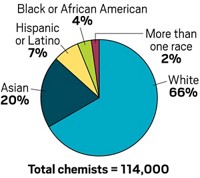Advertisement
Grab your lab coat. Let's get started
Welcome!
Welcome!
Create an account below to get 6 C&EN articles per month, receive newsletters and more - all free.
It seems this is your first time logging in online. Please enter the following information to continue.
As an ACS member you automatically get access to this site. All we need is few more details to create your reading experience.
Not you? Sign in with a different account.
Not you? Sign in with a different account.
ERROR 1
ERROR 1
ERROR 2
ERROR 2
ERROR 2
ERROR 2
ERROR 2
Password and Confirm password must match.
If you have an ACS member number, please enter it here so we can link this account to your membership. (optional)
ERROR 2
ACS values your privacy. By submitting your information, you are gaining access to C&EN and subscribing to our weekly newsletter. We use the information you provide to make your reading experience better, and we will never sell your data to third party members.
Careers
Age diversity in science
by Bibiana Campos Seijo
May 22, 2017
| A version of this story appeared in
Volume 95, Issue 21
In C&EN we regularly run feature stories that exemplify diversity in the chemical sciences and how workplaces are adapting to create a more welcoming and inclusive environment for underrepresented and marginalized groups.
For example, last year we explored the experience of chemists in the lesbian, gay, bisexual, and transgender community who face barriers to promotion or adversity on the job, and how they navigate these challenges.
We also reported on a gender survey carried out by the Open Chemistry Collaborative in Diversity Equity (OXIDE) that tracks the overall percentage of women faculty at top chemistry departments. Look for the companion survey on underrepresented minorities in chemistry departments later this year.
Each year we also report goings-on from the annual National Organization for the Professional Advancement of Black Chemists & Chemical Engineers meeting and how NOBCChE is working to grow and nurture the next generation of black chemists and engineers.
So we often write about diversity and inclusion for chemists from the LGBT community, for women chemists, and for chemists from other nationalities and races, but we don’t tend to write about age diversity in the chemical sciences, or any science, all that frequently.
I recently came across a paper that broached this subject in the context of the U.S. science and engineering workforce. In many ways, the scientific community is becoming more diverse, but this does not seem to be the case when it comes to age. According to the authors of the study, the scientific workforce in the U.S. is aging rapidly.
The authors observed an increase in the mean age of scientists, which went from 45.1 in 1993 to 48.6 in 2010. The age distribution of the scientific workforce in the U.S. between 1993 and 2010 shows a significant decline in the share of scientists aged 35–53, with a significant increase in the share older than 53. Interestingly, although the workforce as a whole is also aging, it has a substantial mass at younger ages compared with the scientific workforce. It is also aging at a slower pace: from 42.2 to 45.4 from 1993 to 2010.
Much of this trend is driven by the aging of the large baby boom cohort that is currently employed. The authors call this a “demographic momentum” that is likely to continue for the next two decades as the cohorts of baby boomers age into their 60s and early 70s. A small percentage (8%) of the increase in scientists’ mean age can be attributed to a decline in retirement at universities since 1994, the year when mandatory retirement was eliminated. Other reasons for this age distribution of the scientific workforce include declining mortality and fertility rates.
Worryingly, the current trend predicts further aging of the scientific workforce in coming years. Younger scientists may be crowded out. Besides the human cost, which is not insignificant, what will be the impact of this trend in productivity and innovation? If we assume that both decline with age—and there are plenty of studies presenting mixed views on the matter—are we saying that productivity and ability to innovate in the U.S. may suffer in the short and medium term? It’s a grim prospect. We must work to ensure the voices of the younger generations of scientists are heard.
Diversity comes in many forms—gender, religion, sexual orientation, socioeconomic background, and of course age—and is an ambitious goal that requires a conscious and concerted effort by all in the community. Successfully bringing together people of various backgrounds with various perspectives and experiences to help solve global challenges should become the hallmark of our generation.
Views expressed are those of the author and not necessarily those of ACS.



Join the conversation
Contact the reporter
Submit a Letter to the Editor for publication
Engage with us on Twitter